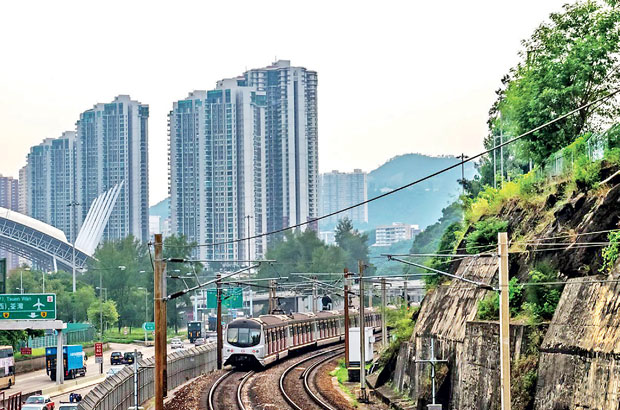10 Aug 2017 - {{hitsCtrl.values.hits}}

BY Sharad Saxena
Rising urban population growth and private vehicle ownership are making Asian cities unlivable. City dwellers lose precious time in traffic jams, where they also suffer the negative health impact of deadly air pollution.
Congestion seems like an unfixable problem – yet a few cities in the region’s most advanced countries have come up with a solution.
One of these cities is Tokyo, Japan. A training I attended there last month provided me with a wonderful opportunity to explore one of the best examples of how to develop an ultra-efficient mass public transport system by using an innovative financing method.
In Tokyo, traffic is light and free flowing at 9.15 on a Friday morning. Compare that with EDSA, Metro Manila’s main thoroughfare, during rush hour on any weekday: traffic is chock-a-block and literally crawling.
The difference is that in Tokyo, most passenger trips are made on public transport. Given the small proportion of journeys by private vehicles, it is no surprise that road traffic is so light.
How did Tokyo achieve this impressive feat? By building a public transport system that is so efficient and extensive that most citizens would rather take the subway than drive to work.
Clearly this is an obvious solution that many Asian cities would like to emulate. A good public transport system can transform a city, making it more attractive and livable for urban dwellers.
Unfortunately, it’s also very expensive and fare revenue alone cannot cover the costs.
Public funds are often limited and few cities have the capacity to expand the public transport infrastructure to meet the growing demand. Most cities in Asia struggle even to just maintain the existing public transport infrastructure and service levels.
So, how was Tokyo able to do it without spending more public money? The novel solution—at the time—was land value capture (LVC).
LVC finances better
public transport
LVC is the process of “capturing” the increase in the value of land generated by improved accessibility. Better access adds value to an area, which is reflected in land and property values.
The idea is based on the premise that most people are willing to pay a premium to enjoy the advantages of living or working close to a good public transport system. The city government “captures” this higher value though taxes and other schemes and recycles the revenue to pay for further improvements to infrastructure.
Tokyo’s private railways implemented LVC on an impressive scale by developing real estate in conjunction with railway line construction. They financed part of the railway development costs with the profits from the real estate development.
In this way, the private railway companies reaped the twin benefits of higher passenger volume coupled with more valuable commercial and residential real estate.
What is the development significance of this approach, particularly for equity?
In most cities in developing Asia, the value of the land created by public investments is captured by the existing property owners or even speculators. Hence, the gains remain in the hands of a few individuals who have no incentive to reinvest the money in better public transport for better access.
LVC offers the opportunity to capture and recycle the gains (value) for public good.
The additional value of the land is recovered—at least in part—by city governments, which then allocate those funds for building new or improving the existing infrastructure that benefits the wider community – especially the poor.
So, can we implement LVC in other cities? This approach is quite well suited to population-dense, congested settings, prevalent in many Asian cities, where people tend to place a much higher
value on accessibility.
India piloting LVC
Hong Kong, China is another good example of a city that has effectively used LVC to develop a state-of-the-art public transport system.
The city government supports sell public land to the public transport authority at lower rates. The transport authority then sells or leases the land at rates that capture the value enhanced by public transport development. The increased value realized from the land is enough to pay for better public transport infrastructure.
What about cities in developing Asia? Can LVC work there too?
The Indian government certainly seems to think so. It is drafting a Value Capture Financing policy that will enable states and city governments to raise funds by tapping into the increased value of land from public investments. The policy itself is the result of several LVC experiments in a few states, including Maharashtra, Tamil Nadu and West Bengal. The cities of Hyderabad and Delhi have also used LVC to develop their metro rail systems. A national framework will encourage wider application of this innovative financing mechanism.
Using LVC to funding public transport infrastructure development can be done in many ways and how the value is transferred may differ from country to country, and city to city.
But the overall goal is to capture some of the future value enhancement that public transport investments are likely to create and bring these out to help finance better public transport infrastructure.
I believe that LVC schemes have the potential to provide much-needed funds to develop high-quality public transport systems in Asia’s cities.
My pleasant memories of train travel in Tokyo are still very fresh. I admit that replicating Tokyo’s success story though LVC in poorer urban settings can be both risky and challenging – perhaps impossible for some cities.
However, if the reward is a transformative public transport system and a highly livable city, it’s a risk that cities in developing Asia should be willing to take.
(Sharad Saxena is Principal Transport Specialist, East Asia Department, Asian Development Bank)
10 Jan 2025 21 minute ago
10 Jan 2025 26 minute ago
10 Jan 2025 2 hours ago
10 Jan 2025 2 hours ago
10 Jan 2025 2 hours ago